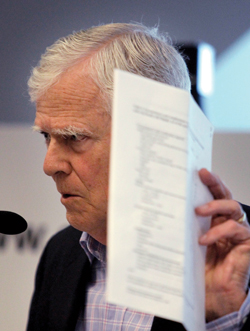Doctors debate the ethics of assisted suicide
The medical community and the world at large are looking at how physician-assisted suicide has played out in Washington, Oregon and Montana. Are these states a bellwether or a death knell for legalizing the issue elsewhere? And how should physicians respond when presented with such requests from their patients?.
During the first 10 months of Washington state's Death with Dignity Act, which took effect in March 2009, 63 people requested and received a lethal dose of medication, according to the first report released by the state's health department.
Of those 63 Washington residents, 47 died, 36 after taking the medication. The report, which tracked the use of physician-assisted suicide from its March 5, 2010 effective date through year's end, also detailed clinician involvement, finding that the prescriptions were written by 53 physicians and dispensed by 29 pharmacists. Although the medications were dispensed in 2009, the report includes any deaths reported to state health officials through early February. The remaining 11 individuals died from other causes or it was unknown whether they had used the medication. (Washington state's legislation stipulates that the action is not “suicide, assisted suicide, mercy killing, or homicide,” and that state reports would not use such terms, instead using the phrase “obtaining and self-administering life-ending medication.” ACP's ethics statements use the term “physician-assisted suicide,” as does this article.)

Washington became the second state to provide a legal mechanism for terminally ill individuals to end their lives after a 2008 voter initiative. In Oregon, that legal right dates back to 1994. Also in the last year, the Montana Supreme Court ruled that state law protects doctors from being prosecuted for assisting terminally ill patients to die.
The prescribing of lethal medication remains highly controversial, in the Pacific Northwest and elsewhere, as clinicians struggle with finding an optimal balance between the autonomy of terminally ill patients and the physician's commitment to do no harm. Depending on the perspective involved, Washington state's initial experience reflects a judicious use of a last-resort option for people with fatal and frequently debilitating illnesses, or a travesty of patient care during the final days of life.
Either way, physicians must decide where they stand on the issue, and those in states where assisted suicide is legal must decide how to care for patients who may want to exercise the option.
Outlining opposing sides
The vast majority of the 47 Washington residents who died after the Death with Dignity Act was passed—79%—had been diagnosed with cancer. Nine people were living with serious neurologic diseases, including amyotrophic lateral sclerosis (ALS). In expressing their end-of-life concerns, all reported fearing loss of autonomy. Other common concerns were loss of dignity, reported by 82%, and loss of the ability to participate in enjoyable activities, reported by 91%.
“It's not about anybody who is really suffering—it's about people who are fearful of suffering.” said Charles Bentz, FACP, a Portland physician and president of the Physicians for Compassionate Care Education Foundation, which opposes the laws in Oregon and Washington. Facing the end of life, some people will become afraid and depressed, he said. “And they become suicidal. Here in Oregon, and now in Washington, instead of recognizing the cry for help, we give a different kind of help. We actually help them to commit suicide.”
Dr. Bentz worries that such laws can be used as a crutch, substituting for a more concerted and caring effort to discern patients' desires in their final days. “If you really connect with the patient, you can find out what is important to them,” he said. “And what are the things that make life meaningful. And there are many ways to make life meaningful, even as functionality declines.”
Tom Preston, MD, a retired Seattle cardiologist and a supporter of the Washington law, agreed that good supportive care is vital. But measures to make a patient comfortable and to ease pain don't necessarily address other symptoms, such as vomiting or loss of bowel control, or existential fears, including becoming a burden, he said.
“There are a lot of people—and I'm one—there's no way I would want to spend the last couple of weeks of my life comatose or semi-comatose, with my family just looking at me,” said Dr. Preston, medical director for Compassion & Choices of Washington, an advocacy group supporting such laws.
Doctor-patient relationship
Washington and Oregon, and now Montana, aren't the only states where physicians are faced with these types of questions, said Timothy Quill, FACP, director of the Center for Ethics, Humanities and Palliative Care at the University of Rochester Medical Center in New York. But once these difficult conversations are shut behind closed doors, it's unclear how they are handled or whether safeguards are being used, he said. For example, he said getting a second opinion (required under the Oregon and Washington laws) might be considered risky in a state where there is no legal mechanism for physician-assisted suicide.
From 1998 to 2009, 460 people have died in Oregon after ingesting a lethal dose of medication, according to data provided by the Oregon Department of Human Services. As in Washington state, most had some form of cancer. Loss of autonomy was the leading concern, cited by 91%. Inadequate pain control and financial implications of treatment ranked much lower, cited by 22% and nearly 3%, respectively.
Dr. Quill, who supports the option of physician-assisted suicide as a last resort, argued that legalization is associated with better physician training and practice in palliative care, such as improved pain management. He cited a 2004 study showing that while 1 in 1,000 dying Oregonians used that state's Death with Dignity law, one in 50 had discussed the option with their physician and one in six with their family members. “There is something about opening up this process that allows for a lot of conversation, but not many cases of assisted dying,” Dr. Quill said. “More open conversation about patients' fears and hopes is a very good thing.”
But Dr. Bentz believes that the Oregon and Washington laws undercut the essence of the doctor-patient relationship. True compassion means to suffer with someone, he said. “In reality, what we do is we walk with patients though their life's journey. That's what physicians do.”
How, he asks, can a patient fully trust a physician who supports assisted suicide? “And who would actually be willing to take your life?” he said. “It does something to the relationship.”
Among physicians who do participate, there are signs of unease, said Courtney Campbell, PhD, a bioethicist based at Oregon State University and a fellow at The Hastings Center. Dr. Campbell, who has studied the Oregon and Washington laws in respect to hospice care, pointed out that Washington's data show that the prescribing physician was only present 8% of the time when the medication was taken. In 34% of the Washington cases, no clinician attended. In Oregon, from 1998 to 2009, the prescribing physician was present 24% of the time.
“What it raised from an ethical perspective was whether a good number of physicians in some sense not legally, but perhaps morally, may have abandoned their patients,” said Dr. Campbell, the Hundere Professor of Religion and Culture at Oregon State's department of philosophy.
He acknowledged that physicians must respect patient autonomy and choice, but also maintained that the doctor-patient relationship is jeopardized if the lethal medication is handled like just another pharmacy transaction.
“If you are going to participate, you need to participate beyond more than just being the technician that prescribes and dispenses the medication,” he said. “You need to have a full-fledged relationship here and that would mean being at the bedside, whenever possible.”
Handling conversations
Both sides on this volatile issue do agree on one point. Physicians in states where assisted dying is legal should think through, in advance, how they feel about their participation and be direct with their patients.
Physicians who are uncomfortable should clearly state so when the patient first raises the subject, proponents said. Don't deflect the conversation or make vague statements, such as “I'll keep you comfortable,” that can be misinterpreted by the patient, said Robb Miller, executive director of Compassion & Choices of Washington.
In some instances, physicians have expressed support for the law but discovered at the eleventh hour that they couldn't follow through, leaving their patient stranded, Mr. Miller said. “It's much easier for you to say that you'll write the prescription than to actually do it.”
In theory, the Washington law's requirements, including the requisite waiting periods, can be fulfilled in as few as 15 days, Mr. Miller said. But in practice it has required several weeks and sometimes months, especially if the individual lives in a rural region of the state, where it can be more difficult to locate a supportive physician, he said.
Individuals who do obtain the medication report peace of mind, he said. “Some have held their medication for months. And some never use it. Many people just want the medication for insurance, just to know that if things get too rough they can use the medication. Some say their suffering is easier because it's voluntary,” he said.
Dr. Quill believes that physicians will increasingly face such questions, as baby boomers age and push for maximum control over their dying process. “They are very used to having choices,” he said. “I think many of them are going to say, ‘I want access to this in addition to excellent palliative care.’”
He co-wrote a paper, published in 2003 in Annals of Internal Medicine, advocating that ACP, among other medical organizations, should adopt a position of “studied neutrality,” in recognition that physicians of goodwill and various convictions sit on both sides of the issue. The American Academy of Hospice and Palliative Medicine has chosen that stance in its position statement on physician-assisted death.
ACP officially opposes legalization, saying the practice can undermine patient trust and distract from ongoing efforts to improve end-of-life care. (The relevant policy paper is online. )
Prior to the passage of the Oregon and Washington laws, one worry was that patients would request lethal medication in situations of inadequate pain control or out of fear of being a burden on family, said Lois Snyder, JD, director of ACP's Center for Ethics and Professionalism. To date, those fears haven't been borne out, she said.
Instead, individuals who access the laws worry about loss of control or autonomy, raising other issues, she said. “Good pain control, for example, is an ethical obligation of physicians and that must be addressed at the end of life. But there are concerns that people want to medicalize what is a process that shouldn't be medicalized in trying to gain total control over death. Medicine can't solve all of our problems,” she said. “The physician's role is to be a healer and comforter, but not necessarily to give people control over the manner and timing of death.”
ACP officials haven't received any complaints related to the current laws, Ms. Snyder said. If a patient approached a physician in a state where physician-assisted suicide is legal and requested help, referral would be an option, she said. “But the College doesn't support the practice.”
Dr. Bentz, who has been approached by patients about utilizing Oregon's Death with Dignity law, feels strongly that there is only one humane physician path. If patients ask about the law, take the time to explore why they are interested, he stressed. “Don't truncate the conversation. That can be seen as a sign of rejection.”
He described one of his patients, a man terminally ill with lung disease, who wanted to use the law. The patient was fearful of his final moments, scared he would die gasping for breath.
Dr. Bentz assured him he would not be alone. “I said, ‘When it comes that time, I'm going to be there with you. We are going to have hospice there with you. We will give you medications. You will not be uncomfortable. And I will be available to you.’ And his shoulders relaxed. He took a deep breath. And all of a sudden he was fine.”
The man died soon after, with Dr. Bentz providing support as his hospice physician.





